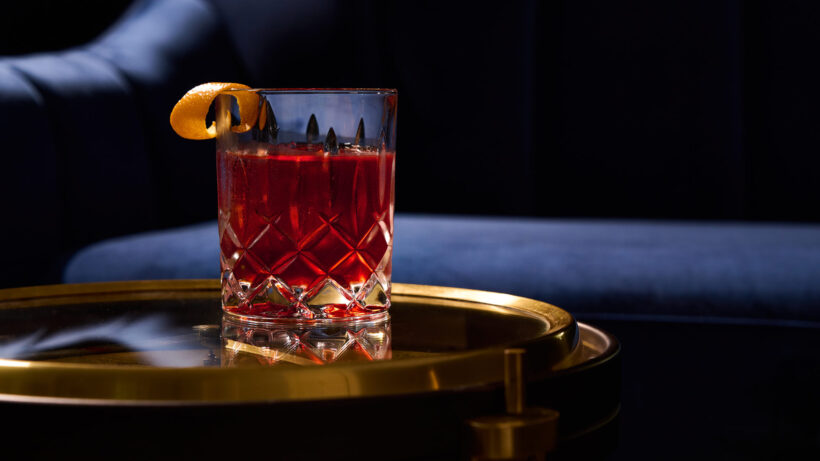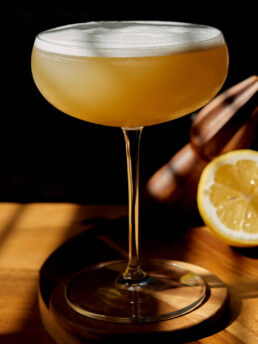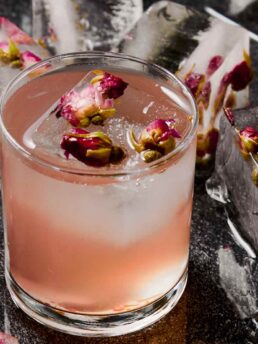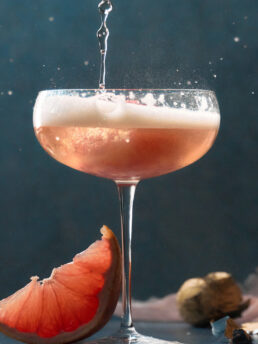Night Cap Negroni: with Cocchi Dopo Teatro Vermouth Amaro

I call it the “night cap” Negroni! Why you ask? This version of the classic Negroni cocktail uses a vermouth amaro that is actually made to be sipped as a digestif instead of an apéritif like most vermouths. Dopo Teatro or “after theatre” refers to the Italian tradition of sipping vermouth with expressed lemon after an evening at the theatre. It’s deep, complex flavor gives this Negroni cocktail more nuance and interest than anything I can get at a regular bar.

Get the Recipe: Night Cap Negroni
Ingredients
- 1 oz Campari
- 1 oz Cocchi Dopo Teatro Vermouth Amaro
- 1 oz Leopold's Summer Gin
- 1 expressed orange peel
- 2 dashes orange bitters, (optional)
Equipment
- 1 rocks glass
- 1 y-peeler or paring knife
- 1 small cutting board or plate
- Ice
- 1 cocktail mixing glass
- 1 measuring glass or jigger
- 1 bar spoon
Instructions
- Place a rocks glass in the freezer 15-30 minutes before making the cocktail.
- When ready, clean the skin of an orange. Then, use a y-peeler or knife to create a roughly 1in x 2in (2.5cm x 5cm) long strip of orange peel. Clean up the edges with a knife and gently cut away any pith that may be attached to the underside of peel. Set your garnish aside.
- Next measure and pour your ingredients into a large, ice-filled mixing glass. Stir with a bar spoon for 30-45 seconds, to chill the cocktail.
- In a separate (now chilled) glass, add a single extra large ice cube and pour in the chilled cocktail liquid.
- Express your orange peel over the drink by holding the top and bottom of peel horizontally and facing out. Squeeze down to release the oils. Rub the outside of the peel against the rim of the glass and slip it into the drink.
- Sip and enjoy!
Notes
- If you don’t have fresh oranges, use 2 dashes of orange bitters. And, feel free to use both if you like!
- Once opened, store your vermouth in the refrigerator for between 1-2 months. Remember, it’s wine with liquor in it. And, while the spirits slow down the fermentation process that happens when wine is open, it’s not going to last forever.
- Don’t have access to the gin or vermouth listed? Use a citrus forward gin of your choosing for the same flavor profile and try to find a Vermouth di Torino. (see FAQ for suggestions)
- Pith is bitter, so don’t skip separating it from the peel if you plan not to clean up the edges of the garnish.
- Try not to touch the front of the peel too much and hold it by the edges. Your fingers and too much manipulation can take some of the oils off the peel before you express it, leaving less for your cocktail. Your fingers will smell nice though. 😉
- If you taste the Negroni after stirring and it’s too strong, keep stirring to dilute it a tad more. This isn’t about being cool and dealing with the sting of alcohol, it’s about balance. The dilution during chilling is meant to get rid of the gin’s alcohol burn and mellow the Campari’s bitterness.
Nutrition

Frequently Asked Questions
Do you have fresh lemon? Cocchi Dopo Teatro Vermouth Amaro is particularly yummy with expressed lemon peel, so it’s a great substitute for orange peel.
How about bitters? Bitters are meant to be used like the spice rack in your kitchen and they would work beautifully in this application as well. Without fresh oranges, orange bitters are the next best thing. Lemon bitters would go over well here too.
In order to keep the same flavor profile, I would not suggest using any other bitters. However, if you want to experiment, I’ve found sassafras (root beer) bitters to be a delicious addition.
Keep in mind, there are already sooo many herbs and spices in vermouth amaro (especially this one) that adding bitters with similar flavor profiles could throw off the flavor balance the distillers worked so hard for.
It’s all about the total mass if the ice cube compared to its surface area with stirred cocktails. Dilution is part of the initial stir, which can be done with normal sized cubes. Once your night cap Negroni is balanced and poured, the idea is to keep it tasting the same for as long as possible.
The smaller the individual cubes (think pellet ice or crushed ice) the faster they will melt and further dilute your Negroni. Bleh! Large ice cubes keep your drink cold and balanced. They just melt sooo much slower than small ones. It’s not make or break, but large ice cubes are better for anyone looking to elevate their home bar.
YESSSS! The cool thing about making cocktails without fresh juice in them, is that they are perfect for batching and leaving them pre-made in your freezer (i.e. freezer door cocktails). Batching is such a fast easy way to have interesting cocktails ready for your or a group event.
To batch 8 Night Cap Negroni cocktails at once, mix 1 cup (240ml) of each ingredient and then add in 2tsp (10ml) of orange bitters.
Do you plan to pour your pre-chilled Negronis straight from the refrigerator or freezer? If so, add in 1 cup (240ml) of water to the mix before chilling. This acts as the stirring step, where you chill and dilute to balance the cocktail. Without the water, your cocktail will be very strong.
If you want to find your personal preference for dilution follow these steps:
1. pour the drink as written;
2. stir with ice until you are happy with the flavor;
3. pour the liquid back into a measuring cup;
4. subtract the original measurement from what is now in the glass,
That amount is your water “dilution” preference amount. Scale from there! Mine is between .75-1oz (22.5-30ml) per drink.
If you’re adding the cocktail to a beverage dispenser with ice, this step can be skipped. Just make sure to add the mixed cocktails and ice 15-30 minutes before serving. This way, there is time for dilution.
The first Negroni was an Americano (Campari, sweet vermouth, and soda water) that was requested with gin instead of water. Classic Negronis are equal parts Campari, Gin, and Sweet Vermouth.
You will find a lot of variations of the Negroni out there, but purists will say it’s not a Negroni without Campari (I’m in this boat). Others believe a Negroni is the combination of a high proof spirit, a bitter liqueur, and vermouth. (To me: this is negroni-esque, but you’ve made a different cocktail.)
Any way you stir it, all variations are delicious!
Vermouth is simply a fortified and aromatized apéritif wine. Meaning it’s made with a base of wine that is fortified with a stronger neutral spirit (typically brandy) to add shelf life. It’s then infused with various herbs, spices, and barks. Europeans require the use of wormwood (most commonly used in absinthe) in the infusion, in order for the spirit to be categorized as a vermouth. Americans do not have this requirement, so more modern vermouths have lots of flavor variations.
There are a number of styles ranging from extra dry to sweet, but the main three are sweet, dry, and blanc. Traditional sweet vermouths are more-often-than-not red in color and Italian in origin. While dry vermouths hail from France and are the color of straw. Blancs (French) are also called Bianco (Italian) and come with a he-said-she-said story of origin. They boast the same sweetness as a red but the color of a dry vermouth.
Most vermouths, including rosso “red” vermouth, are actually made with white wine. Afterwards, they are colored with caramelized sugar or a caramel coloring. The tannins in red wine can mess with the flavor and the process of making vermouth, so they aren’t used often.
Here’s the skinny on vermouth in Negronis.
Traditionally red “rosso” sweet Italian vermouths are used in Negronis. In quite a few riffs on a Negroni, like the white Negroni, bartenders will simply use a sweet vermouth. This move gives them access to blanc vermouth in their mixes.
In order to be a sweet vermouth, the sugar content must be above 130g/liter. (about 1 cup to a little more than 1 quart) The sugar is needed to balance out the bitterness of the Campari.
If I’ve said it once, I’ll say it again…you can do absolutely anything you want!
Use a style of vermouth listed in the previous section.
Or, stick to a similar flavor profile if you cannot find the Dopo Teatro. This style of Negroni uses Vermouth di Torino. Martini & Rossi and Cocchi both produce wonderful sweet Vermouth di Torinos if you cannot find the Cocchi Dopo Teatro Vermouth Amaro.
Vermouth and vermouth amaro are both made by infusing fortified wine with a wide range of bittering agents, including herbs, botanicals, and sometimes quinine.
Vermouth Amaro, unlike vermouth, is characterized by this bitterness as well as complex herbal flavors. It is typically consumed as a digestif (after dinner) and is served neat or on the rocks.
Vermouths are typically used as mixers in cocktails and spritzes or sipped as apéritifs.
For the same flavor profile, go for something orange, lemon, and coriander forward with less pepper and juniper pungency. Think light and clean.
Some other brands that follow that prompt are… Big Gin London Dry, Empress 1908 (the purple one), Roku London Dry, Sorgin Gin and Bombay Sapphire.
If you want things to get a little interesting, try this with a bourbon barrel aged gin. (not bourbon barrel finished or rested, make sure to check). The addition of vanilla, caramel, and woody notes to this cocktail are a whole new experience.
Some brands to incorporate are Barrel Reserve Big Gin (can you tell I love them?), Koval Barreled Gin, Bar Hill Tom Cat Reserve Gin.
Honestly, use bourbon or rum (like Kill Van Kull Rum) if you really want to change it up and go wild! have fun!



